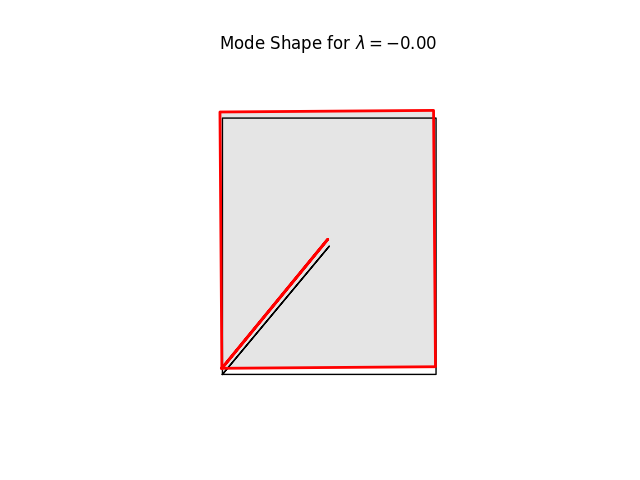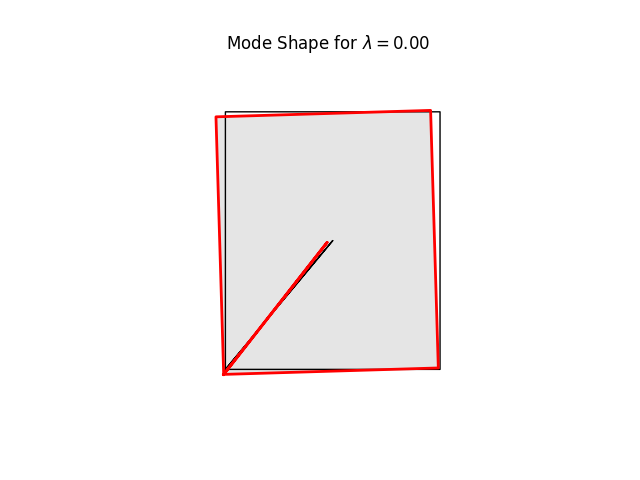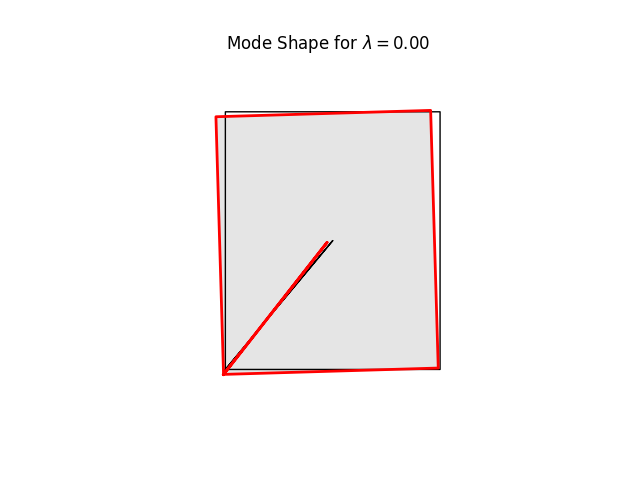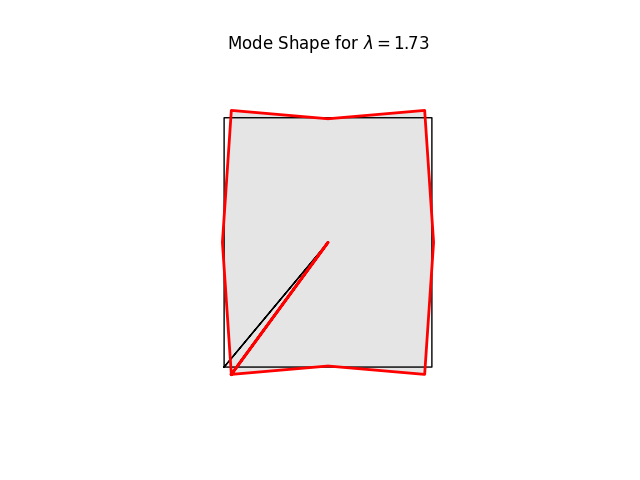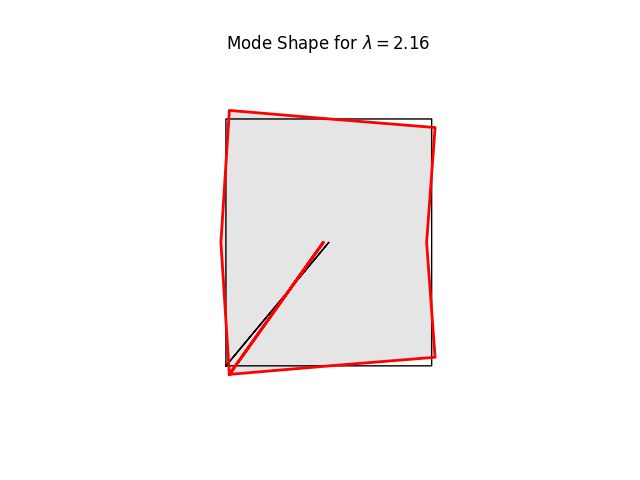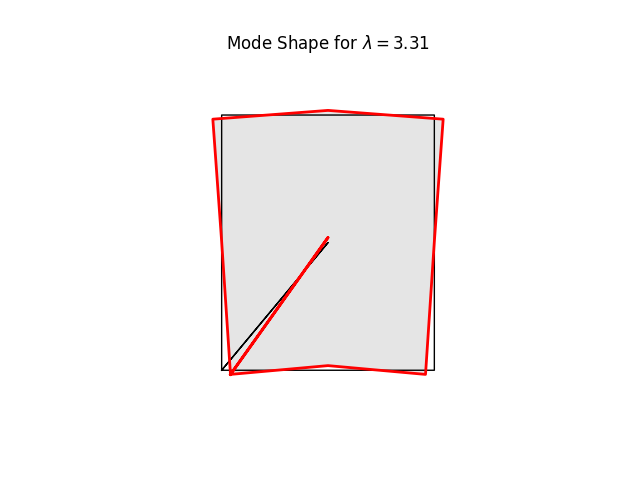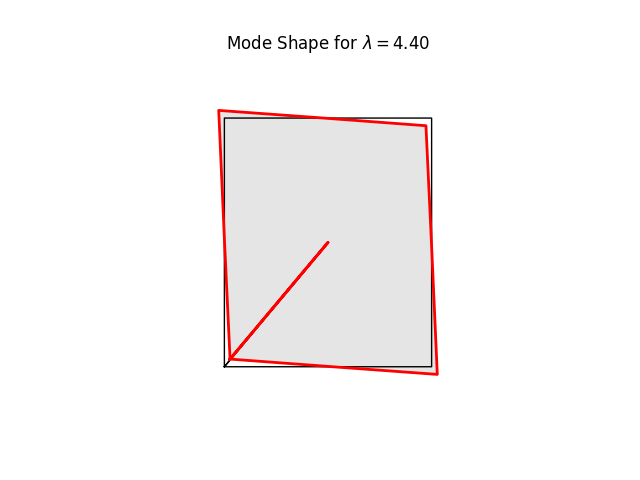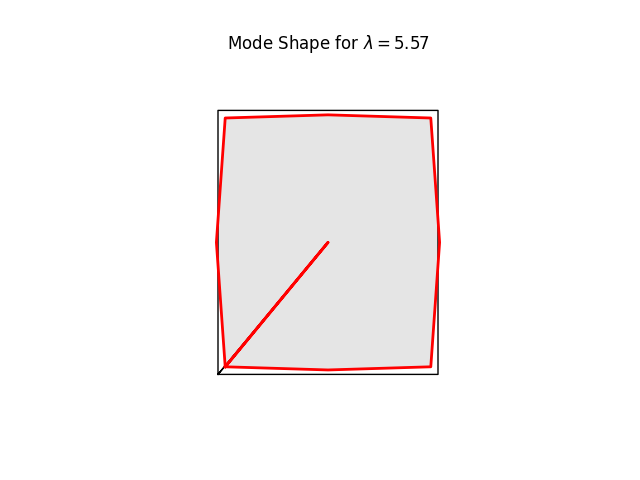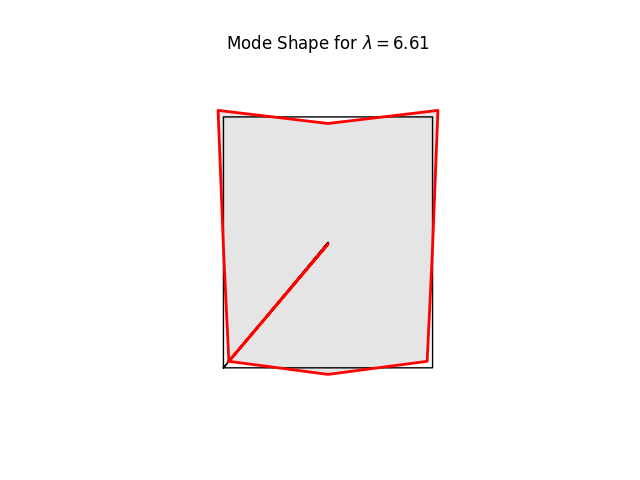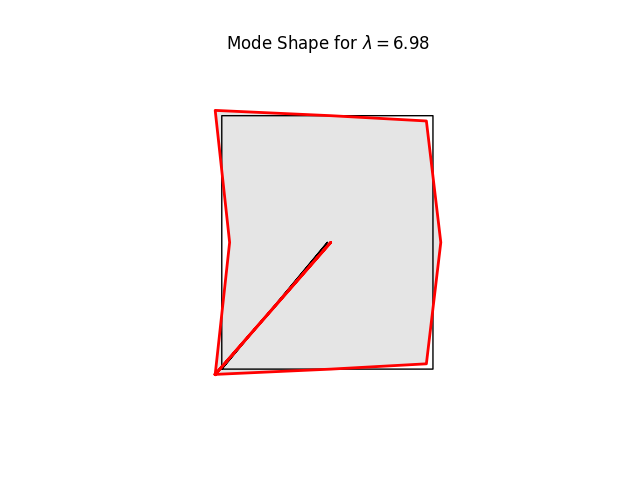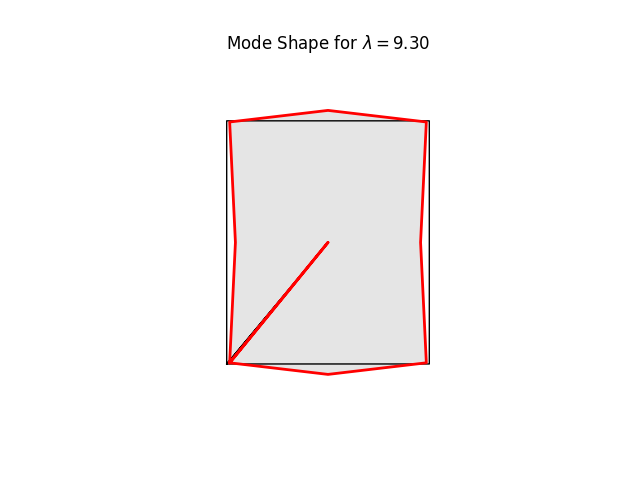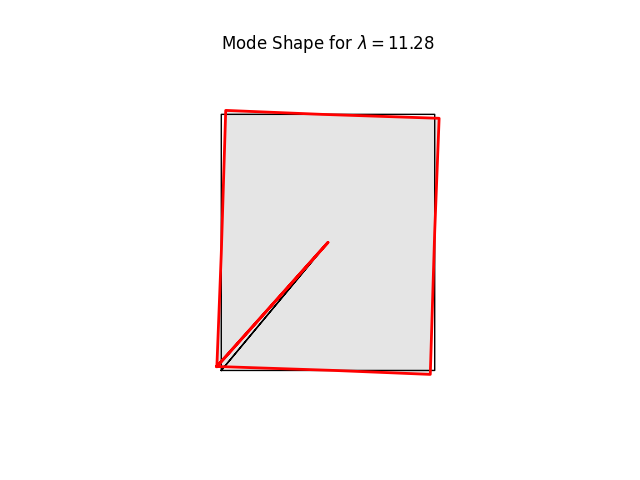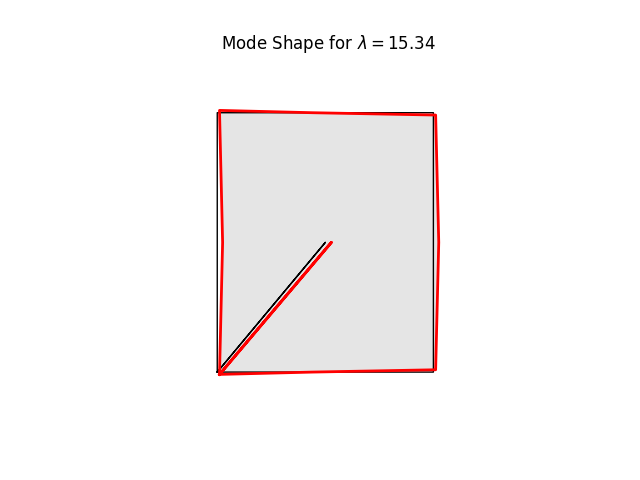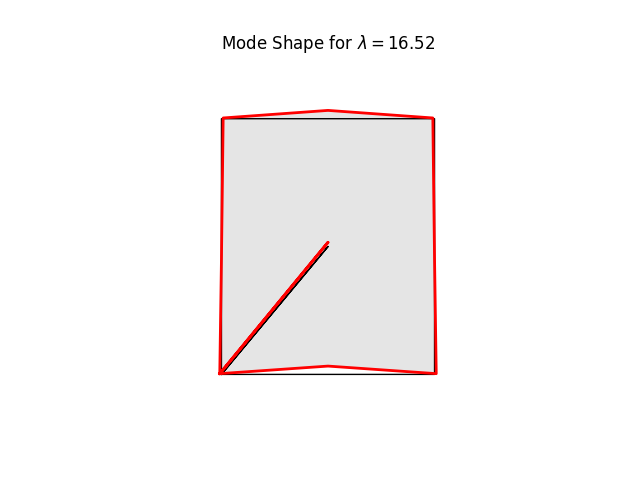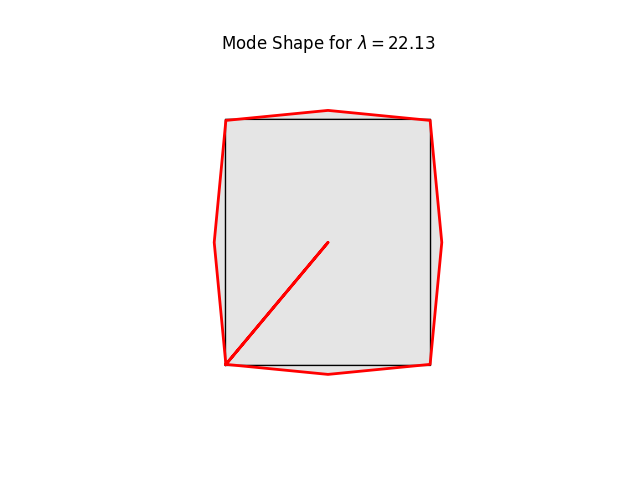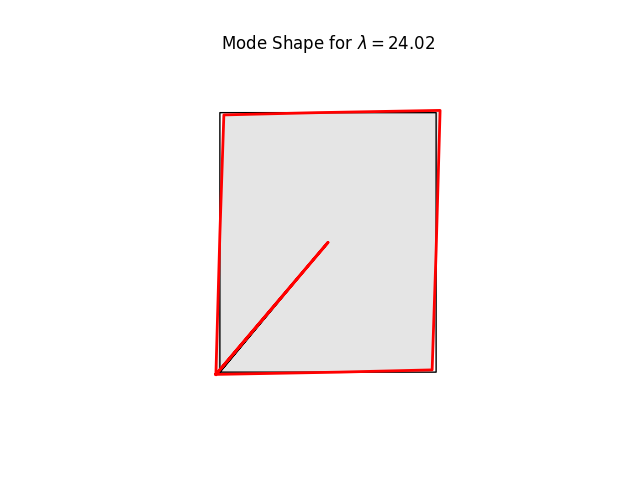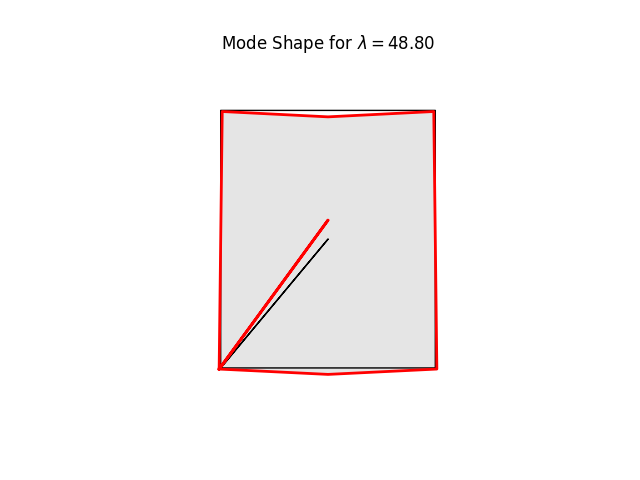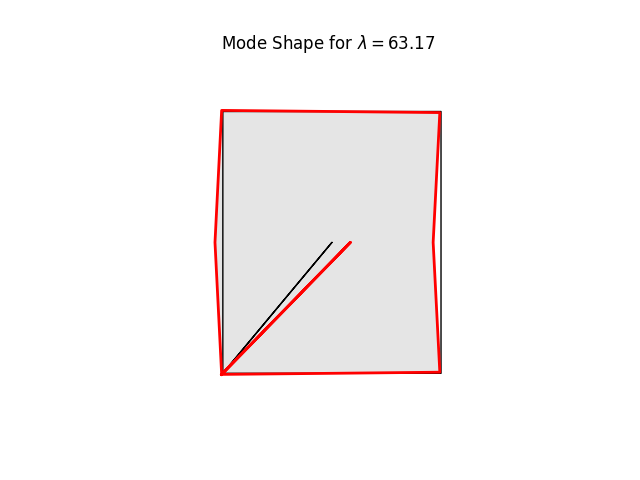Note
Go to the end to download the full example code.
Element Testing: Analyzing Modes and Energy
- Basic implementation test with applied loads.
Testing the tangent stiffness computation.
free free
^ ^
| |
3-----2 -> free
| | >
| a | > (w = 1.0)
| | >
0-----1 -> free
width: 10.
height: 10.
Material parameters: St. Venant-Kirchhoff, plane stress
E = 10.0
nu = 0.30
t = 1.0
Author: Peter Mackenzie-Helnwein
# sphinx_gallery_thumbnail_number = 5
import numpy as np
from femedu.examples import Example
from femedu.domain import System, Node
from femedu.solver import NewtonRaphsonSolver
from femedu.elements.linear import Quad
from femedu.elements.linear import Quad9
from femedu.materials import PlaneStress
# -------------------------------------------------------------
# Example setup
# -------------------------------------------------------------
params = dict(
E = 10., # Young's modulus
nu = 0.3, # Poisson's ratio
t = 1.0, # thickness of the plate
fy = 1.e30 # yield stress
)
a = 10. # length of the plate in the x-direction
b = 12. # length of the plate in the y-direction
model = System()
model.setSolver(NewtonRaphsonSolver())
nd0 = Node( 0.0, 0.0)
nd1 = Node( a, 0.0)
nd2 = Node( a, b)
nd3 = Node( 0.0, b)
nd4 = Node( a/2, 0.0 )
nd5 = Node( a, b/2 )
nd6 = Node( a/2, b )
nd7 = Node( 0., b/2 )
nd8 = Node( a/2, b/2 )
model.addNode(nd0, nd1, nd2, nd3) # corner nodes
model.addNode(nd4, nd5, nd6, nd7) # midside nodes
model.addNode( nd8 ) # center node
elemA = Quad(nd0, nd1, nd2, nd3, PlaneStress(params))
elemB = Quad9(nd0, nd1, nd2, nd3, nd4, nd5, nd6, nd7, nd8, PlaneStress(params))
# model.addElement(elemA)
model.addElement(elemB)
elemA.setSurfaceLoad(face=1, pn=1.0)
model.plot(factor=0.0, title="Undeformed system", show_bc=1)
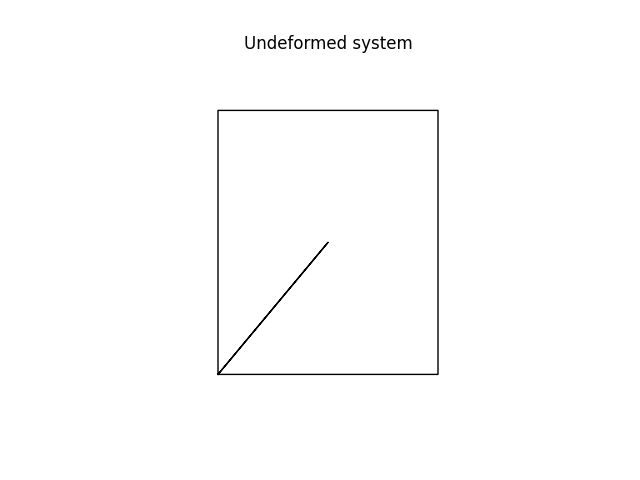
We can have a quick look at the stiffness mode shapes using the buckling-mode plotter. These are simply eigenvalues and eigenvectors of Kt at the current load level (0.0)
model.setLoadFactor(0.0)
model.solve()
# np.save('../../../Kplate.npy', model.solver.Kt)
for k in range(18):
model.plotBucklingMode(mode=k, factor=1.0)
+
Note the three rigid body modes (lam=0.0). It can be shown that all three are linear combinations of translations in x and y-directions and a rigid body rotation.
Now it is time to add boundary conditions, apply loads and check the convergence behavior.
nd0.fixDOF('ux', 'uy')
nd1.fixDOF('uy')
nd3.fixDOF('ux')
model.setLoadFactor(1.0)
model.solve()
+
The output shows that we do have a quadratic rate of convergence.
Let’s finish off with a nice plot of the deformed system.
model.plot(factor=1.0)
model.report()
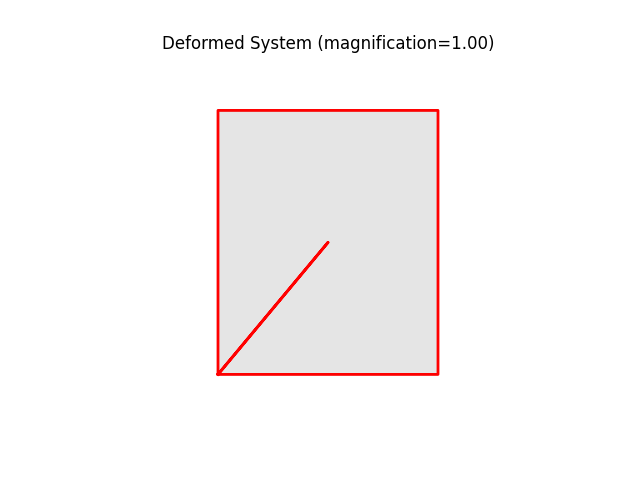
System Analysis Report
=======================
Nodes:
---------------------
Node_620:
x: [0.000 0.000]
fix: ['ux', 'uy']
u: [0.000 0.000]
Node_621:
x: [10.000 0.000]
fix: ['uy']
u: [0.000 0.000]
Node_622:
x: [10.000 12.000]
u: [0.000 0.000]
Node_623:
x: [0.000 12.000]
fix: ['ux']
u: [0.000 0.000]
Node_624:
x: [5.000 0.000]
u: [0.000 0.000]
Node_625:
x: [10.000 6.000]
u: [0.000 0.000]
Node_626:
x: [5.000 12.000]
u: [0.000 0.000]
Node_627:
x: [0.000 6.000]
u: [0.000 0.000]
Node_628:
x: [5.000 6.000]
u: [0.000 0.000]
Elements:
---------------------
Quad9_842: nodes ( Node_620 Node_621 Node_622 Node_623 Node_624 Node_625 Node_626 Node_627 Node_628 )
material: PlaneStress
strain (0): xx=-1.110e-16 yy=-1.110e-16 xy=5.551e-17 zz=6.661e-17
stress (0): xx=-1.586e-15 yy=-1.586e-15 xy=2.135e-16 zz=0.000e+00
strain (1): xx=2.220e-16 yy=0.000e+00 xy=9.382e-17 zz=-6.661e-17
stress (1): xx=2.440e-15 yy=7.320e-16 xy=3.609e-16 zz=0.000e+00
strain (2): xx=2.220e-16 yy=-1.110e-16 xy=2.914e-16 zz=-3.331e-17
stress (2): xx=2.074e-15 yy=-4.880e-16 xy=1.121e-15 zz=0.000e+00
strain (3): xx=2.220e-16 yy=0.000e+00 xy=6.711e-18 zz=-6.661e-17
stress (3): xx=2.440e-15 yy=7.320e-16 xy=2.581e-17 zz=0.000e+00
strain (4): xx=0.000e+00 yy=0.000e+00 xy=6.939e-17 zz=-0.000e+00
stress (4): xx=0.000e+00 yy=0.000e+00 xy=2.669e-16 zz=0.000e+00
strain (5): xx=-2.220e-16 yy=2.220e-16 xy=-1.892e-16 zz=-0.000e+00
stress (5): xx=-1.708e-15 yy=1.708e-15 xy=-7.276e-16 zz=0.000e+00
strain (6): xx=0.000e+00 yy=8.882e-16 xy=1.943e-16 zz=-2.665e-16
stress (6): xx=2.928e-15 yy=9.760e-15 xy=7.473e-16 zz=0.000e+00
strain (7): xx=-2.220e-16 yy=-2.220e-16 xy=1.949e-16 zz=1.332e-16
stress (7): xx=-3.172e-15 yy=-3.172e-15 xy=7.495e-16 zz=0.000e+00
strain (8): xx=0.000e+00 yy=0.000e+00 xy=1.388e-17 zz=-0.000e+00
stress (8): xx=0.000e+00 yy=0.000e+00 xy=5.338e-17 zz=0.000e+00
Total running time of the script: (0 minutes 0.287 seconds)
